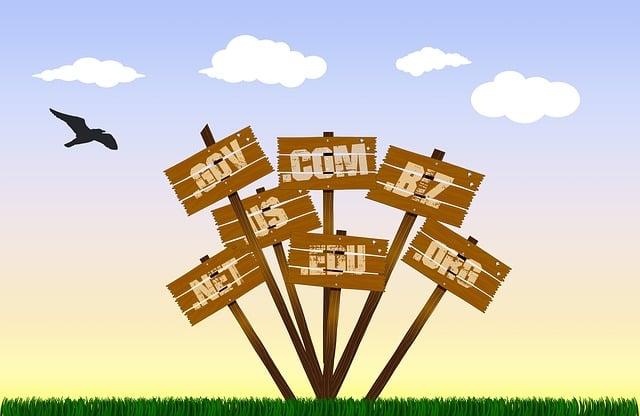Table of Contents
- Understanding the Domain Name Market and Its Dynamics
- Identifying Profitable Domains Through Strategic Research
- Best Practices for Acquiring and Valuing Domain Names
- Effective Marketing Strategies to Sell Your Domains
- Navigating Legal Considerations in Domain Flipping
- Q&A
- Final Thoughts


Understanding the Domain Name Market and Its Dynamics
The domain name market operates much like any other marketplace, driven by supply and demand dynamics. Individuals and businesses alike are on the lookout for catchy, memorable domain names that resonate with their brand identity or personal vision. As the internet continues to grow, certain domain names become increasingly valuable due to their short length, keyword relevance, or cultural significance. Thus, understanding these factors is essential for anyone looking to flip domain names profitably.
Moreover, various trends influence the valuation of domain names, including:
- Industry Specificity: Domains with keywords directly related to high-demand industries, such as technology or health, often attract higher bids.
- Geographical Relevance: Domains that include geographical indicators can appeal to local businesses.
- Brandability: Names that are easy to pronounce and remember regularly fetch higher prices.
The process of flipping domain names can be lucrative, but it requires astute market awareness and strategic planning. An important element in this endeavor is the ability to assess current market trends and predict where demand will shift in the future. Conducting thorough research to gauge buyer interest, along with proper timing in the selling process, can lead to substantial profits. Keeping an eye on emerging technologies and societal shifts ensures that you can position your offerings effectively, securing a competitive edge in this ever-evolving marketplace.


Identifying Profitable Domains Through Strategic Research
When venturing into the world of domain flipping, the key to success lies in thorough research. Start by focusing on domains that resonate with current trends, emerging industries, or niche markets. Utilize tools like Google Trends and keyword research platforms to pinpoint keywords that are gaining traction. Additionally, consider evaluating the domain’s length; shorter, memorable names often yield higher resale values. With potential buyers in mind, identifying terms that evoke emotion or curiosity can significantly enhance a domain’s appeal.
Furthermore, examining past sales data can provide invaluable insight. Resources such as NameBio offer historical data on domain name sales, which allows you to gauge pricing trends and demand for similar domains. When assessing a domain’s value, look for characteristics like brandability, search engine optimization (SEO) potential, and existing traffic. Being mindful of the extension (.com, .net, etc.) is also critical, as certain TLDs tend to perform better in specific industries.
In addition, assessing the competition in your chosen niche is paramount. Analyze how competitive the market is for the keywords associated with the domain names you’re interested in. You can create a simple comparison table to help visualize the potential resale values based on various factors:
| Domain Name | Keyword Popularity | Estimated Value | Competition Level |
|---|---|---|---|
| TrendyTechGadget.com | High | $2,500 | Moderate |
| EcoFriendlyLiving.net | Medium | $1,200 | Low |
| FitnessGuruAdvice.com | High | $3,000 | High |
By leveraging these strategies and tools, you’ll be able to identify and acquire promising domain names, setting the stage for successful flipping ventures in the digital marketplace.


Best Practices for Acquiring and Valuing Domain Names
When venturing into the domain flipping business, understanding the best practices for acquiring domain names is crucial. Start by conducting thorough research on potential domains before making a purchase. Look for short, memorable names that convey meaning, as they tend to attract more buyers. Additionally, prioritize domains with established SEO value, such as those that have relevant keywords or an existing traffic history. This can considerably enhance their selling potential in the future.
Valuing domain names involves a mix of qualitative and quantitative analysis. Consider factors such as the domain extension (.com, .net, etc.), its length, and the presence of keywords. Domains with popular extensions and short, keyword-rich names typically fetch higher prices. Additionally, compare similar sales on platforms like GoDaddy Auctions or Sedo to gauge market trends. Here’s a simple table to illustrate different attributes and their impact on domain value:
| Attribute | Impact on Value |
|---|---|
| Domain Length | A shorter domain usually has a higher value |
| Keyword Presence | Keywords relevant to popular searches increase value |
| Extension Type | Common extensions (.com) generally have more demand |
| History | Domains with a history of traffic are more valuable |
approach the acquisition process strategically. Utilize domain registrars, marketplaces, and even social media to find great opportunities. Networking with other domain investors can lead to private sales and leads that aren’t always publicly advertised. Remember to keep an eye on trends; emerging industries often provide lucrative domains that are not yet popular. By staying informed and agile in your approach, you can maximize your chances of flipping domains successfully.


Effective Marketing Strategies to Sell Your Domains
When it comes to successfully selling your domains, employing innovative marketing strategies can set you apart in a competitive market. Identify your target audience—understanding who would be interested in your domain names allows you to tailor your marketing efforts accordingly. For instance, if you own a domain that is exceptionally catchy for a tech startup, direct your marketing towards entrepreneurs and tech enthusiasts. Utilize platforms such as social media, domain auction sites, and specialized forums to reach potential buyers effectively.
Another crucial aspect is to leverage the power of SEO in your listings. Optimize your domain name descriptions using relevant keywords that potential buyers may use when searching for domains. This not only increases visibility but also enhances the perceived value of your domains. Consider the following to ensure your listings are appealing:
- Craft compelling descriptions highlighting the uniqueness and potential uses of the domain.
- Use attractive visuals or logos to accompany your listings.
- Incorporate call-to-action phrases to encourage immediate inquiries or purchases.
it’s essential to network with industry professionals and join relevant online communities. This opens up opportunities for collaboration and direct sales. Engage in discussions and showcase your domains where possible. You can also establish strategic partnerships with web developers or branding agencies who might need domains for their projects. By building relationships within the industry, you not only increase your visibility but also gain insights into market trends that can inform your selling strategies.
Navigating Legal Considerations in Domain Flipping
When venturing into the realm of domain flipping, it’s essential to understand the various legal considerations that can impact your success. Trademark issues often arise with domain names that may unintentionally infringe on existing business or brand trademarks. Engaging in a thorough trademark search before acquiring a domain can shield you from potential legal repercussions. Additionally, be vigilant about the use of names that mimic well-known brands, as this can lead to costly legal battles that may extend your flipping timeline.
Another significant aspect to consider is the terms of service agreements of domain registrars. Each registrar may have its own policies regarding domain transfers, ownership disputes, and acceptable use. Familiarizing yourself with these terms can prevent potential headaches during the transfer process and ensure a smoother transition for your buyers. Additionally, keep the following points in mind:
- Ownership Verification: Ensure clear evidence of ownership.
- Transfer Rules: Understand the specific procedures for transferring domains.
- Dispute Resolution: Know the process for addressing disputes, should they arise.
It’s also wise to stay informed about cybersquatting laws. Under the Anti-cybersquatting Consumer Protection Act (ACPA), registering a domain that is confusingly similar to a trademark with the intent to profit can lead to severe penalties. Furthermore, consider leveraging a domain privacy service to protect your personal information from unwanted solicitations or legal threats. Implementing a proactive approach to understanding these elements ultimately enhances your domain flipping strategy and mitigates risks associated with legal challenges.

